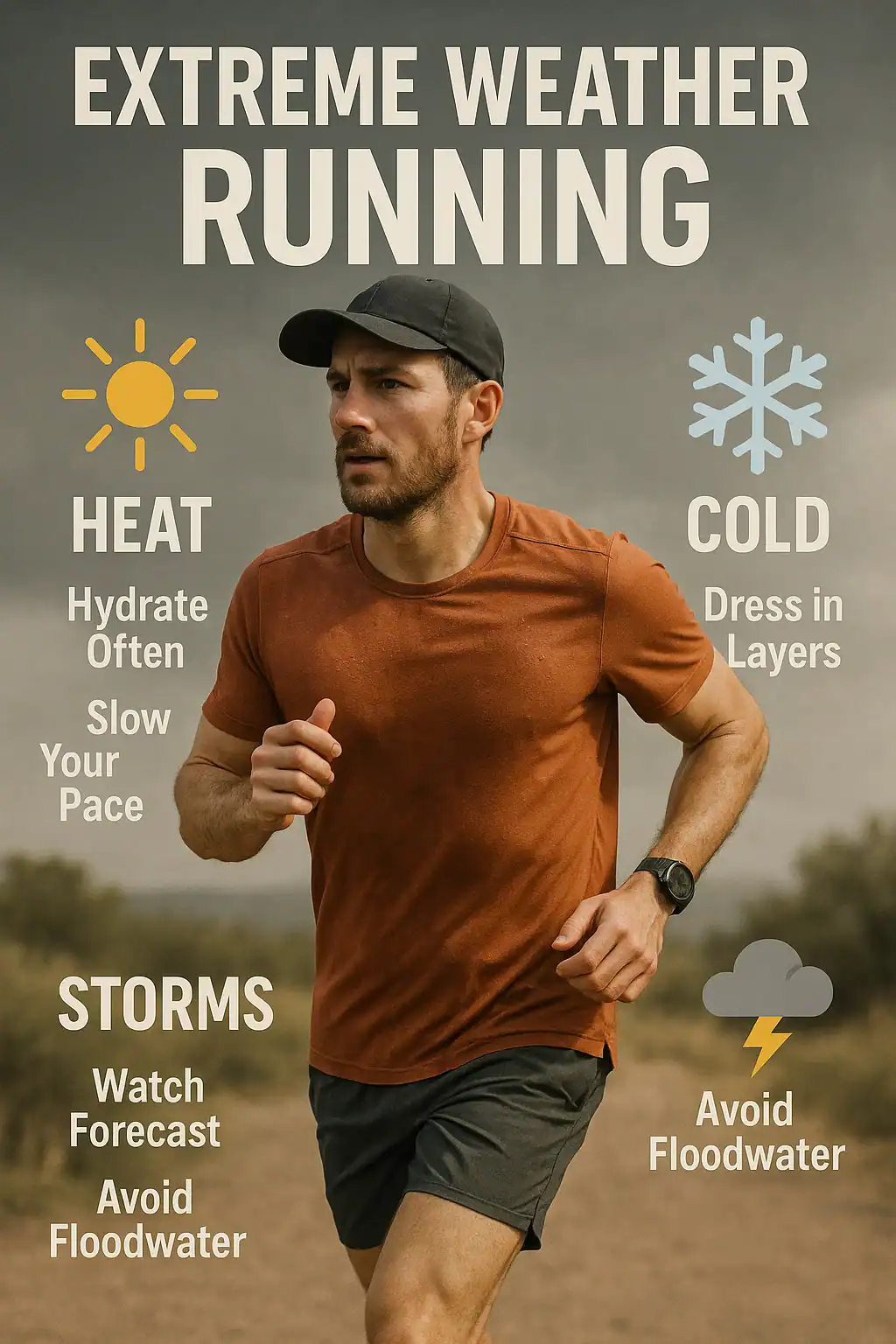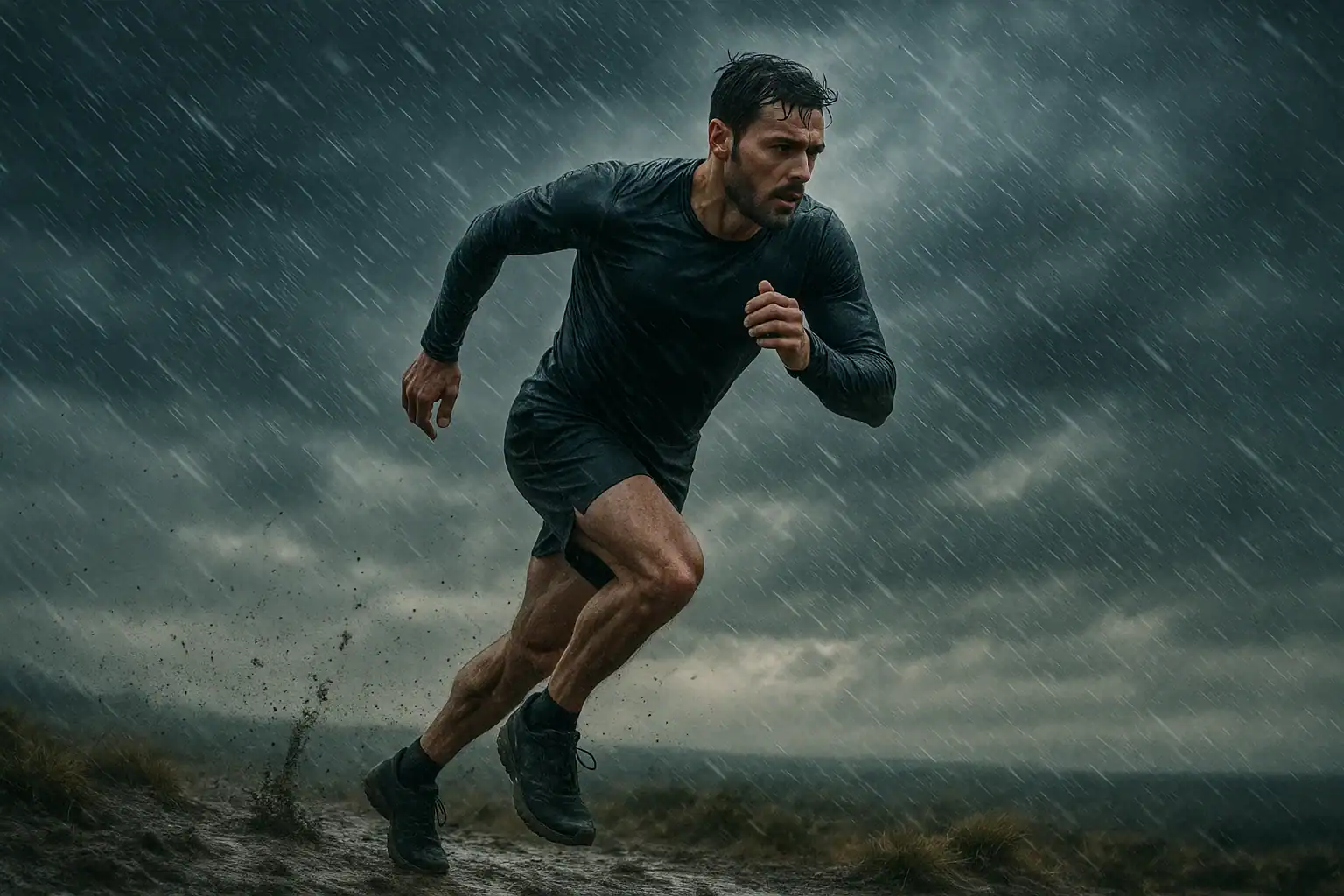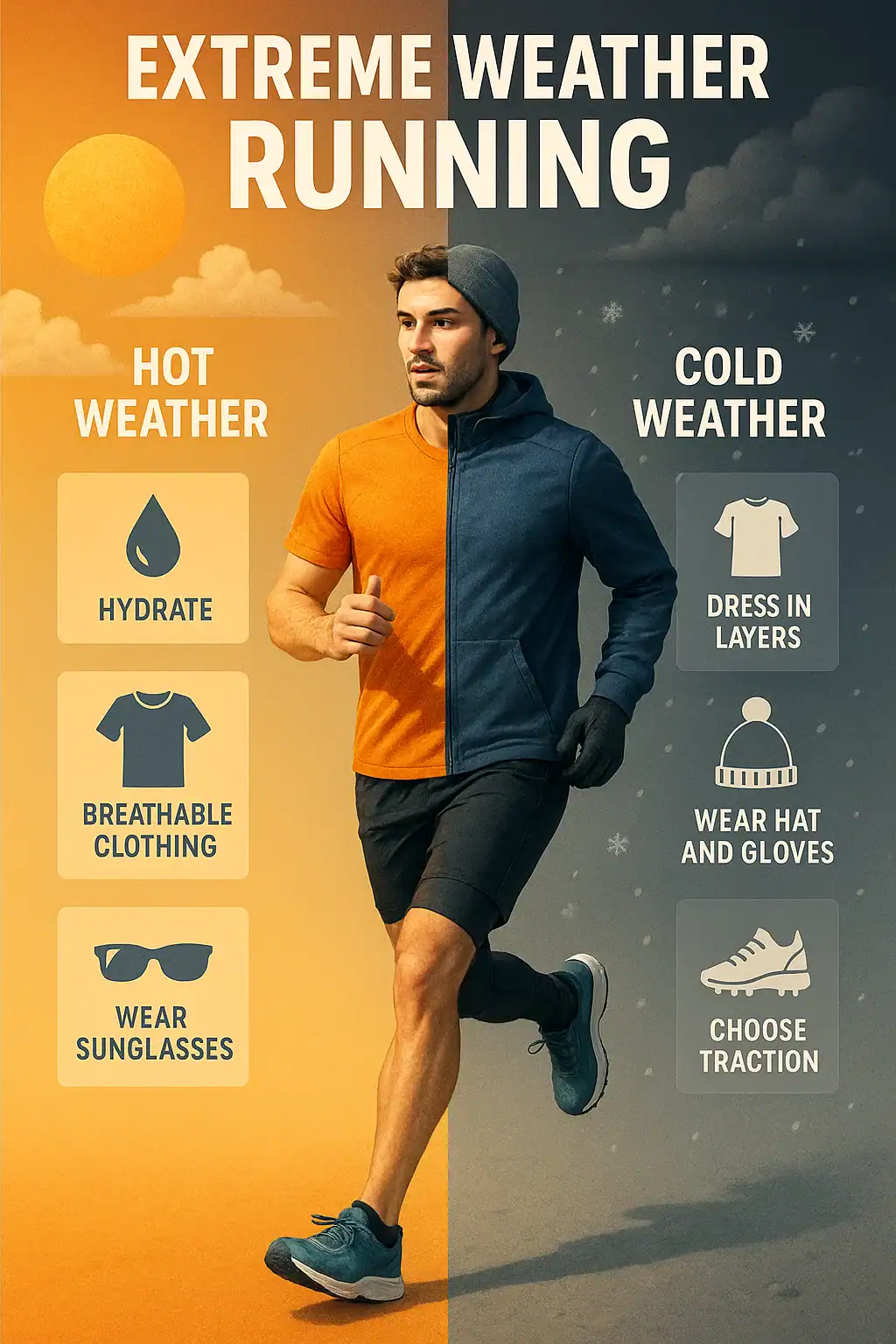Dreaming of that perfect 55°F run? Reality check: running performance can drop 1.5-3% for every 10°F rise above 60°F. And in the cold? Your body can burn up to 40% more energy just staying warm, even before wind chill bites, which can drastically increase frostbite risk.
Ignoring these numbers isn’t tough; it’s a gamble with your health and performance. This guide cuts the fluff. It’s your unfiltered, experience-backed playbook to intelligently conquer extreme weather, not just endure it. Let’s get real about running strong and safe, no matter the forecast.

Key Takeaways:
- Hydration is Key: Drink water regularly; consider electrolyte drinks to prevent heat stress.
- Dress Appropriately: Choose light, breathable fabrics in heat; layer with moisture-wicking materials in cold.
- Run Smart: Opt for cooler times of day in heat; face the wind first for better endurance.
- Invest in Gear: Use waterproof jackets for rain and proper footwear for snow or ice.
- Listen to Your Body: Adjust pace, take breaks, and stop if feeling unwell to avoid injuries.
- Stay Safe: Inform someone of your route, carry your phone, and wear reflective gear in low visibility.
Brutal Truths Before You Even Think About Lacing Up:
- Your Body Isn’t a Superhero (Especially in Extremes): Newsflash: you’re going to be slower. It will feel harder. This isn’t a moral failing; it’s basic biology. Trying to “push through” like it’s a perfect 60°F day is a fast track to injury, burnout, or just plain hating your run. My critical take: The biggest mistake I see is runners refusing to adjust their ego to the thermometer.
- Gear is a Tool, Not a Magical Force Field: Yes, good gear helps. It makes the intolerable, tolerable. But the fanciest jacket won’t turn a blizzard into a beach day. My opinion: People often overspend on marginal gear gains while neglecting fundamental preparation.
- “Listen to Your Body” Isn’t Fluffy Advice; It’s a Damn Commandment: This is the only rule that’s truly non-negotiable. That little voice saying “this feels really, really wrong”? It’s usually right. Stubbornness in the face of genuine physical distress is just idiotic.
- The Misery is Mostly Mental (But Not Entirely): A huge part of conquering tough weather is mindset. Can you embrace the suck? Good. But there’s a fine line between mental toughness and recklessness. Critical thought: Don’t let “mental toughness” become an excuse to ignore genuine physical limits or safety concerns.
The Nitty-Gritty: How Your Body Wages War (and Sometimes Loses)
Before we strategize for specific weather assaults, understand this: your body is working its metaphorical butt off.
- Heat Hell: Your cardiovascular system basically freaks out, desperately pumping blood to your skin to radiate heat. Guess what gets less blood? Your muscles. So, that feeling of your heart trying to escape your chest at a “normal” pace? Yep, that’s why.
- Arctic Antics: Your body goes into survival mode, pulling blood away from your fingers, toes, ears, and nose to keep your core warm. Smart for not dying, less smart for feeling your feet or avoiding frostbite.
My point: Acknowledging these limitations isn’t weakness; it’s intelligence. You wouldn’t expect your car to perform the same way going uphill in a sandstorm as it does on a flat, clear road, would you? Treat your body with the same mechanical respect. And frankly, effective breathing techniques while running become even more critical when your system is already under duress.
The Heat Monster: Outsmarting the Sizzle & Swelter
Running in oppressive heat can feel like wearing a sauna suit while jogging through molasses. It’s a beast, and a dangerous one if you treat it casually.
STOP. THE. RUN. IF:
- You’re dizzy, confused, or feel like you’re losing your bearings (this is a BIG one, folks – heatstroke is no joke).
- You’re about to (or actually do) vomit.
- Your skin is weird – either cool and clammy OR hot and dry (especially if you’ve stopped sweating – very bad sign).
- A headache is pounding like a drum.
- Muscle cramps are crippling you, not just a niggle.
- Your heart rate is so high it feels like it’s trying to exit your body, and it doesn’t match your effort.
My No-BS Heat Survival Kit:
- Hydration: It’s Not a Pre-Run Ritual, It’s a Damn Lifestyle:
- Critical Debunk: That idea you can “load up” on water an hour before a hot run? Mostly nonsense. Consistent, day-in-day-out hydration is what truly primes your system.
- Water is Good, Electrolytes are Your Best Friends (Especially for Long/Sweaty Runs): After an hour in the heat, or if you sweat like a broken faucet (like me!), water alone won’t cut it. You’re losing salt and other crucial minerals. My take: Forget most sugary “sports drinks” for regular training; they’re often calorie bombs. Good electrolyte tabs or unsweetened powders are your allies. Understanding the science behind nutrition and hydration in running performance isn’t just for elites; it’s for anyone who doesn’t want to bonk or cramp up.
- Sip. Don’t. Gulp. Think hummingbird, not camel.
- Embrace the Dark (or at Least the Dim): Early morning or very late evening. Honestly, there’s no debate here. Running under the midday summer sun is just asking for a beatdown unless you’re specifically heat-training for a desert ultra (and even then, with extreme caution).
- Dress Like You Mean It (Meaning, Barely At All):
- Light colors, loose fits, and genuinely breathable fabrics. Dark colors are heat magnets. Cotton is your enemy – it becomes a heavy, soggy mess.
- My Strong Opinion: This is not the time for modesty if it compromises cooling. Shorter shorts? Yes. Lightweight, moisture-wicking singlets? Absolutely. Less fabric is often more.
- Sun Protection is Not Vain, It’s Vital: A light, brimmed hat. UV-blocking sunglasses. High-SPF, sweat-resistant sunscreen. Sunburn isn’t just painful; it actively hampers your body’s cooling mechanisms.
- Kill Your Ego Before the Heat Kills Your Run: SLOW. DOWN. Walk the uphills. Take unscheduled breaks. Your “usual” pace is irrelevant. Critical truth: Trying to maintain your cool-weather pace in stifling heat is the single biggest mistake I see runners make, and it’s a recipe for misery or worse. Sensible adjustments are crucial to prevent common outdoor running injuries when conditions are this demanding.
- Acclimatization: It’s Real, But It’s Not Magic (and it takes serious time): If you must race in the heat, you need to gradually introduce your body to it over weeks. Not a couple of runs the week before. And if you’re new to running or just landed in a hot climate? Extreme caution is your best friend.
Winter’s Bite: How to Run When It’s Freezing (and Not Hate Life)
There’s a certain raw beauty to a winter run… if you’re not a human popsicle. Get the prep wrong, and you’re staring down frostbite, hypothermia, or just a truly miserable experience.
Cold’s Treachery – Don’t Ignore These:
- Numbness, or worse, waxy-looking skin on your extremities (hello, frostnip, the evil precursor to frostbite).
- Shivering so hard your teeth are playing a drum solo (that’s early hypothermia, and it’s not a good sign).
- Slurring your words, feeling confused, or suddenly becoming clumsy (this is advancing hypothermia – it’s serious, get help/warmth NOW).
- A fatigue that feels like it’s in your bones.
My Battle-Tested Cold Weather Protocol:
- Layering: The Art of Your Personal Thermostat: This isn’t just about piling clothes on; it’s strategic.
- Base Layer (Skin Contact): Snug, moisture-wicking (merino wool or a good synthetic. If you wear cotton here, you’ve already lost). Its sole job: get sweat OFF your skin.
- Mid-Layer (Insulation): Fleece or a technical insulating fabric. Traps your precious body heat. My experience: You might skip this on milder cold days if your outer layer has some insulation, or if you run hot.
- Outer Layer (The Shield): Wind-resistant IS KEY. Water-resistant/proof is a bonus, especially in wet cold. But it must be breathable, or you’ll create your own personal swamp inside.
- Critical Thought: It’s far better to start a run feeling slightly cool (you’ll warm up!) than to overdress and become a sweaty, then freezing, mess. You can always remove a layer; you can’t easily dry out mid-run.
- Guard Your Vulnerable Bits (Extremities are Drama Queens):
- Head & Ears: A hat that covers your ears is non-negotiable. You lose a surprising amount of heat from your noggin. A neck gaiter/buff is a winter runner’s secret weapon – so versatile.
- Hands: Insulated, windproof gloves or mittens. Personal preference: Mittens are often warmer because your fingers share heat.
- Feet: Quality wool-blend or thermal running socks. Hot tip (pun intended): Don’t go so thick your shoes become tourniquets. Restricted blood flow = colder feet.
- The Wind Chill Lie Detector: That “feels like” temperature? That’s the actual temperature your body is fighting. Wind is a brutal multiplier of cold. If possible, plan your route to have the wind at your back on the return leg. It’s a massive psychological boost.
- Footwear: When Grip is God:
- Cold and clear: Your usual road shoes might suffice with warmer socks.
- Snow/slush/potential ice: My firm stance: This is where trail running shoes with aggressive lugs earn their keep. For actual ice, don’t be a hero – use screw-in studs or traction devices (Yaktrax, etc.). A slip on ice can end your season.
- Be a Human Lighthouse! Winter often equals dim, dreary, or dark conditions. Reflective gear and a headlamp or blinking lights aren’t optional; they’re survival tools. Assume every car is driven by someone texting.
- Warm-Up Like You Mean It: Dynamic movements indoors first. Get the blood flowing before you hit the cold. Static stretching on cold muscles? Bad idea.
The Invisible Enemy: Conquering Soul-Crushing Wind
Wind. It doesn’t just slow you down; it saps your will to live and makes even mild temperatures feel arctic.
- Face the Fury First: If it’s an out-and-back, run into the wind on the way out. That tailwind on the way home will feel like you’ve sprouted wings. Trust me, this mental trick is gold.
- Ear Plugs (Almost): Wind howling in your ears is incredibly fatiguing. A hat or headband covering them is a must.
- Aerodynamics 101: A snugger (but not sausage-casing tight) outer layer cuts through wind better than a billowy parachute.
- Exposed Routes? Expect a Fight: If your route is wide open or at altitude, wind will likely be your main sparring partner. Factor its demoralizing effect into your effort.
Rain: Friend or Foe? (Spoiler: Depends on Your Gear & Attitude)

A rainy run can be beautifully cleansing or a chafe-filled, slippery descent into misery.
- The Waterproof vs. Water-Resistant Conundrum:
- Truly waterproof jacket: Keeps rain out. Can also trap sweat like a Ziploc bag unless it’s a high-end, genuinely breathable fabric (think Gore-Tex and its pricey cousins).
- Water-resistant gear: Fends off light rain/drizzle. Breathes better. Will eventually surrender in a deluge.
- My unfiltered opinion: For most non-freezing rain, I’ll take a highly water-resistant, breathable shell and accept getting a bit damp. Why? Because a “waterproof” jacket that doesn’t breathe well makes you wet from the inside out, which is often worse. In cold rain, however, waterproofness becomes paramount to stave off hypothermia.
- Brimmed Hat > Hood (Usually): Keeps rain off your face and out of your eyes far more effectively.
- Slippery When Wet (Footwear Edition): Good grip is essential. Some love GORE-TEX shoes for rain. My counterpoint: If water does get in (and it often does, over the ankle), GORE-TEX shoes can become little foot-bathtubs that don’t drain. I often prefer shoes that drain quickly, even if my feet get wet initially.
- Chafe is a Four-Letter Word: Lube up! Wet fabric + friction = ouch.
- Be Extra Visible: Rain means drivers see even less. Bright colors and lights are non-negotiable.
- The Post-Run Strip Tease: Get out of those wet clothes STAT. A chill can set in fast.
When the Air Itself is an Pollutant: Running in Iffy Air Quality
Wildfire smoke, city smog, sky-high pollen – sometimes the air is actively trying to hurt you.
- AQI is Your Oracle: Check the Air Quality Index (AirNow.gov or most weather apps). Learn what those numbers mean for your health.
- When in Doubt, Stay Out (of the Bad Air): My blunt advice: Your lungs are not replaceable. If the AQI is in the unhealthy zones, hit the treadmill, do some cross-training, or take a rest day. It’s just not worth the long-term damage.
- Traffic Sucks (For Your Lungs Too): If AQI is borderline, run when/where pollution is lower – usually early AM, in parks, away from car-congested arteries.
- Masks for Exercise? Some specialized masks can filter pollutants. My experience: They can also make breathing during exertion feel like sucking air through a straw. This is a very personal call, heavily dependent on AQI and individual sensitivity.
The Slippery Slope: Navigating Snow & Ice (Without Ending Up on Your Butt)
Snowy runs can be serene. Icy runs are an orthopedic surgeon’s dream.
- Footwear is Your Life Insurance Policy Here:
- Light Snow/Slush: Trail shoes with decent lugs.
- Packed Snow/Any Hint of Ice: Don’t mess around. Add traction devices (Yaktrax, Kahtoola MICROspikes, etc.) or use shoes with built-in metal studs. A fall on ice can be catastrophic.
- Deep Snow: This is less running, more “high-intensity slogging.” Fun in its own way, but expect a massive pace drop and effort spike.
- Shorten Your Stride, Slow Your Roll: Better balance, less chance of a yard sale. This is also a prime time to really focus on how to improve your running form for stability and efficiency in tricky conditions.
- Assume All Snow Hides Ice: Because it often does.
- Blizzards & Ice Storms? This is where common sense needs to scream louder than your training plan. Sometimes, the best run is the one you don’t do. Stay safe.
Special Note: Trail Running – Wild Beauty, Wilder Risks
Taking your run off-road? Trail running adventures can bring thrilling discoveries, but extreme weather amplifies every challenge. That rooty, rocky trail? Now it’s a slip-and-slide. Mountain weather is notoriously fickle. My critical advice: Over-prepare. Check multiple forecast sources. Tell someone your exact route and ETA (and stick to it, or update them). Carry more layers, food, and water than you think you’ll need. And for the love of all that’s holy, wear proper trail shoes with aggressive traction. This isn’t the place for your sleek road racers.
Beyond the Run: The Stuff That Really Makes a Difference

Gear: Smart Investment, Not Obsessive Hoarding
You don’t need the priciest version of every widget. But investing in quality technical fabrics for core items (base layers, a good outer shell, socks, well-fitting shoes) is an investment in your comfort, safety, and ability to actually get out the door. My pet peeve: People who buy the most expensive GPS watch but skimp on decent socks, then wonder why they get blisters. Prioritize! Equipping yourself with essential outdoor running gear isn’t about fashion; it’s about function.
Safety: Not a Suggestion, It’s a Requirement
- The “Tell Someone” Rule is Golden: Especially if you’re heading into a blizzard or a remote trail. Seriously.
- Your Phone: Lifeline or Expensive Brick? Keep it charged. Keep it protected from elements.
- Carry ID: It’s a small thing that could be a very big deal.
- Be the Brightest Thing Out There: Reflective gear, bright colors, lights. Don’t assume anyone sees you.
Don’t just skim this; really internalize these running safety essentials and tips for staying secure. Your life could depend on it.
Post-Run Recovery: The Unsexy Hero of Consistent Training
Extreme weather beats you up more. Period. Skimp on recovery, and you’ll pay.
- Temperature Shock Therapy: Warm, dry clothes immediately after a cold run. A cool (not ice-cold, usually) shower after a scorcher.
- Refuel & Rehydrate Like Your Next Run Depends On It (Because It Does): Protein, carbs, fluids, electrolytes. This isn’t rocket science, but so many runners neglect proper fueling your runs: a comprehensive guide to pre and post-run nutrition.
- Listen to Your Body’s Post-Game Report: You might need more rest, an easier day, or just more TLC. Ignoring this is how niggles become injuries. Remember, comprehensive understanding involves the role of rest and recovery in maximizing your running performance.
Races in “Character Building” Weather
- Throw Your Time Goals in the Trash: Seriously. Survival and smart effort management are your new A-goals.
- Pack for All Four Seasons (Almost): Race morning can be a weather chameleon.
- Course Recon is Your Friend: Know where aid stations are, where the wind will hit hardest, etc.
- DNS/DNF: The Bravest Acronyms in Running: “Did Not Start” or “Did Not Finish.” My firm belief: There is ZERO shame in making a smart safety call. Hypothermia or heatstroke isn’t worth a finisher’s medal. There will be other races.
A Nod to My Fellow “Seasoned” Runners (40+):
Our minds might still write checks our bodies can’t always cash as easily.
- Warm-ups Are No Longer Optional: Especially in the cold. Give your engine time to get humming.
- Our Internal Thermostat Can Get Quirky: We might be less efficient at regulating temperature. Vigilance is key.
- Hydration by the Clock, Not Just by Thirst: That thirst sensation can become a less reliable narrator.
- Recovery Isn’t a Luxury; It’s a Necessity: It might take a bit longer. That’s okay. Be kind to yourself.
There’s a wealth of specific, actionable advice out there for running for seniors that can keep us logging miles safely and happily for decades.
The Unvarnished Truth: Run Smart, Not Just Hard, and You’ll Run for Life
Running in extreme weather isn’t about proving how tough you are (though it definitely builds resilience). It’s about being an intelligent, adaptable, and respectful athlete. It forges a mental grit that makes those “perfect” days feel like a gift.
Embrace the challenge, yes. But respect the hell out of the elements. Prioritize your long-term ability to enjoy this crazy sport over any single, miserable run. Sometimes, the smartest, toughest decision is to hit the treadmill, cross-train, or declare a rest day. Learning to identify that line is perhaps the most critical skill of all.
Now, gear up (intelligently), listen to your gut (and the weather report), and go make the elements your training partner, not your enemy. (Or, you know, wisely choose the couch. No judgment here.)
References:
[1] https://www.rrca.org/education/for-runners/cold-weather-running/
[2] https://www.upmcmyhealthmatters.com/inclement-weather-safety-tips-for-running-in-rain-and-heat/
[3] https://www.fleetfeet.com/blog/running-in-the-heat-a-runners-guide-to-surviving-the-summer
[4] https://jaciwilsonruns.com/winter-running/
[5] https://www.runnersworld.com/uk/health/a776373/running-in-the-heat/
[6] https://www.reddit.com/r/running/comments/htodf9/running_in_extreme_heat/
[7] https://www.treelinereview.com/learn-skills/running-in-the-cold
[8] https://www.vingo.fit/running-for-all/running-hot-or-cold-weather/
[9] https://www.redbull.com/int-en/running-in-the-heat-athlete-tips
[10] https://www.underarmour.com/en-us/t/playbooks/running/running-in-the-cold-guide/
[11] https://www.nyrr.org/run/guidelines-and-procedures/weather-related-running-tips/cold-weather-running
[12] https://www.mcmillanrunning.com/a-runners-guide-to-running-in-the-heat/
[13] https://www.rei.com/learn/expert-advice/winter-running-tips.html
[14] https://www.buxtonwater.co.uk/articles/marathon-and-training/running-in-rain-and-other-weather-conditions
[15] https://www.nytimes.com/2022/08/13/sports/running-in-the-heat.html
[16] https://berkeleyhalfmarathon.com/blog/2024/01/12/running-in-bad-weather-6-tips-to-help-you-stay-safe/
[17] https://godashsports.com/2024/11/06/stay-warm-while-running-in-cold-weather/
[18] https://www.samitivejhospitals.com/article/detail/running-in-any-weather
[19] https://www.rrca.org/education/for-runners/hot-weather-running/
[20] https://www.verywellfit.com/tips-for-running-in-the-heat-according-to-experts-5536871
As a veteran fitness technology innovator and the founder of GearUpToFit.com, Alex Papaioannou stands at the intersection of health science and artificial intelligence. With over a decade of specialized experience in digital wellness solutions, he’s transforming how people approach their fitness journey through data-driven methodologies.
